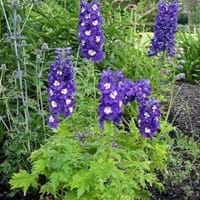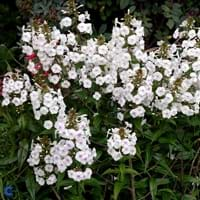Life Span
Perennial
Perennial
Type
Flowering Plants, Ornamental Plants, Shrubs
Flowering Plants
Origin
Africa
United States, Northeastern United States, Mid-Atlantic United States, Southeastern United States, Central United States, South-Central United States
Types
Not Available
Not Available
Number of Varieties
Not Available
Habitat
gardens, meadows
Loamy soils, meadows, moist forests
USDA Hardiness Zone
Not Available
5-8
Sunset Zone
Not Available
1a, 1b, 2a, 2b, 3a, 3b, 4, 5, 6, 7, 8, 9, 10, 11, 12, 13, 14, 18, 19, 20, 21, 22, 23
Habit
Upright/Erect
Upright/Erect
Minimum Width
Not Available
Flower Color
Blue, Indigo, Lavender, Light Purple
White, Pink, Lavender, Violet
Flower Color Modifier
Bicolor
Bicolor
Fruit Color
Non Fruiting Plant
Not Available
Leaf Color in Spring
Green
Green, Dark Green
Leaf Color in Summer
Light Green
Dark Green
Leaf Color in Fall
Green, Yellow green
Dark Green
Leaf Color in Winter
Green, Light Yellow, Tan
Not Available
Leaf Shape
Palmate and toothed
Oblong
Plant Season
Spring, Summer, Fall, Winter
Summer
Sunlight
Full Sun, Partial Sun
Full Sun, Partial Sun, Partial shade
Type of Soil
Clay, Loam, Sand
Clay, Loam
The pH of Soil
Acidic, Neutral, Alkaline
Acidic, Neutral, Alkaline
Soil Drainage
Well drained
Average
Bloom Time
Not Available
Early Summer
Tolerances
Heat And Humidity
Not Available
Where to Plant?
Ground, Pot
Container, Ground
How to Plant?
Seedlings, Stem Cutting
Seedlings, Transplanting
Plant Maintenance
Medium
Medium
Watering Requirements
It cannot sustain wet-feet, Keep ground moist, Requires regular watering, Water more in summer
Do Not over Water, Keep ground moist
In Summer
Lots of watering
Lots of watering
In Spring
Moderate
Moderate
In Winter
Average Water
Average Water
Soil pH
Acidic, Neutral, Alkaline
Acidic, Neutral, Alkaline
Soil Type
Clay, Loam, Sand
Clay, Loam
Soil Drainage Capacity
Well drained
Average
Sun Exposure
Full Sun, Partial Sun
Full Sun, Partial Sun, Partial shade
Pruning
Cut away fading foliage, Do not prune during shooting season, Remove damaged leaves, Remove deadheads
Remove damaged leaves, Remove dead branches, Remove dead leaves
Fertilizers
High-phosphorous fertilizers used, Organic Flower Fertilizer
All-Purpose Liquid Fertilizer, Apply 10-10-10 amount
Pests and Diseases
Bacterial leaf spot, fungus, Mealybugs
Leafhoppers, Pink Root, Powdery mildew, Red blotch
Plant Tolerance
Heat And Humidity
Drought
Flower Petal Number
Single
Single
Foliage Texture
Fine
Medium
Foliage Sheen
Matte
Glossy
Attracts
Butterflies
Hummingbirds, Butterflies
Allergy
Severe allergen, Skin irritation, Skin rash, Throat itching, Vomiting
allergic conjunctivitis, breathing problems, Irritate the mucus membrane
Aesthetic Uses
Beautification, Borders, Showy Purposes, Used for decorating walls, fences, gates, hedges, etc.
Beautification, Cottage Garden
Beauty Benefits
No Beauty Benefits
Improve skin tone, Restores Hair Colour, Skin cleanser
Environmental Uses
Air purification
Air purification, Increases moisture in air, Prevent Soil Erosion
Medicinal Uses
No Medicinal Use
Aging, Antispasmodic
Part of Plant Used
Flowers
Leaves
Other Uses
Used in making blue ink
Air freshner, Cosmetics, Making Sweet Scented Oil
Used As Indoor Plant
No
No
Used As Outdoor Plant
Yes
Yes
Garden Design
Edging, Feature Plant
Cutflower, Mixed Border
Botanical Name
Delphinium elatum
PHLOX maculata
Common Name
Alpine delphinium, Delphium, Candle larkspur, Siberian larkspur, Musk Larkspur,
Meadow Phlox
In Hindi
अल्पाइन Delphinium
मैदानी एक प्रकार का पौधा
In German
Alpine Delphinium
Wiese Phlox
In French
Alpine Delphinium
Meadow Phlox
In Spanish
Alpine Delphinium
prado Phlox
In Greek
Alpine Δελφίνιο
Meadow Phlox
In Portuguese
Alpine Delphinium
Meadow Phlox
In Polish
Alpine Delphinium
łąka Phlox
In Latin
Alpine Delphinium
Phlox meadow
Phylum
Tracheophyta
Magnoliophyta
Class
Magnoliopsida
Magnoliopsida
Order
Ranunculales
Solanales
Family
Ranunculaceae
Polemoniaceae
Clade
Angiosperms, Eudicots
Not Available
Tribe
Not Available
Not Available
Subfamily
Not Available
Not Available
Number of Species
Not Available
Importance of Alpine Delphinium and Meadow Phlox
Want to have the most appropriate plant for your garden? You might want to know the importance of Alpine Delphinium and Meadow Phlox. Basically, these two plants vary in many aspects. Compare Alpine Delphinium and Meadow Phlox as they differ in many characteristics such as their life, care, benefits, facts, etc. Every gardener must at least have the slightest clue about the plants he wants to plant in his garden. Compare their benefits, which differ in many ways like facts and uses. The medicinal use of Alpine Delphinium is No Medicinal Use whereas of Meadow Phlox is Aging and Antispasmodic. Alpine Delphinium has beauty benefits as follows: No Beauty Benefits while Meadow Phlox has beauty benefits as follows: No Beauty Benefits.
Compare Facts of Alpine Delphinium vs Meadow Phlox
How to choose the best garden plant for your garden depending upon its facts? Here garden plant comparison will help you to solve this query. Compare the facts of Alpine Delphinium vs Meadow Phlox and know which one to choose. As garden plants have benefits and other uses, allergy is also a major drawback of plants for some people. Allergic reactions of Alpine Delphinium are Severe allergen, Skin irritation, Skin rash, Throat itching and Vomiting whereas of Meadow Phlox have allergic conjunctivitis, breathing problems and Irritate the mucus membrane respectively. Having a fruit bearing plant in your garden can be a plus point of your garden. Alpine Delphinium has no showy fruits and Meadow Phlox has no showy fruits. Also Alpine Delphinium is flowering and Meadow Phlox is not flowering . You can compare Alpine Delphinium and Meadow Phlox facts and facts of other plants too.





